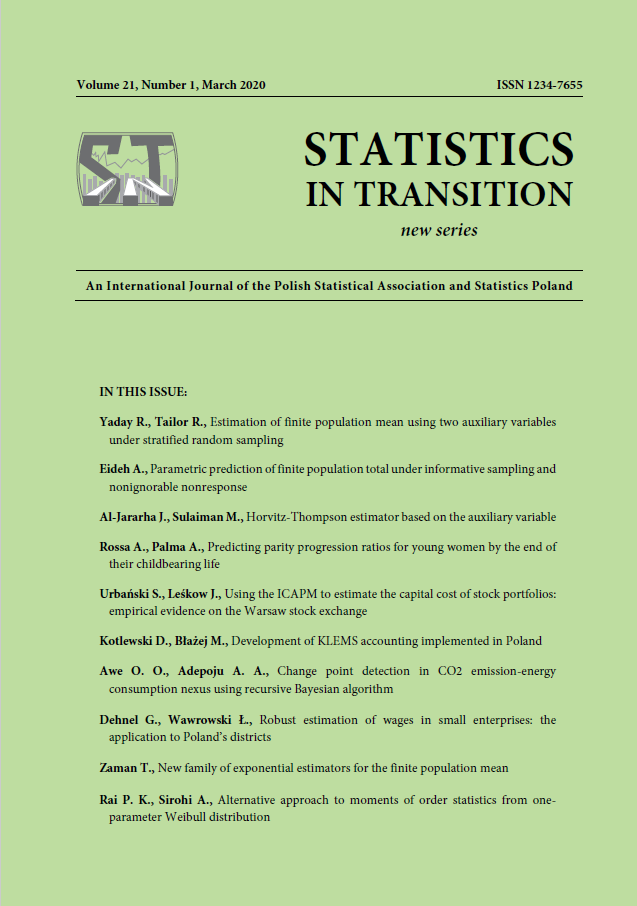ARTICLE
ABSTRACT
This study proposes a new class of exponential-type estimators in simple random sampling for the estimation of the population mean of the study variable using information of the population proportion possessing certain attributes. Theoretically, mean squared error (MSE) equations of the suggested ratio exponential estimators are obtained and compared with the Naik and Gupta (1996) ratio and product estimators, the ratio and product exponential estimator presented in Singh et al. (2007) and the ratio exponential estimators presented in Zaman and Kadilar (2019a). As a result of these comparisons, it is observed that the proposed estimators always produce more efficient results than the others. In addition, these theoretical results are supported by the application of original datasets.
KEYWORDS
ratio-exponential estimators, auxiliary attribute, mean square error, efficiency
REFERENCES
BAHL, S., TUTEJA, R. K., (1991). Ratio and product type estimator, Information and Optimization Science, Vol. XII, pp. 159-163.
JHAJJ, H. S., SHARMA, M. K., GROVE, L. K., (2006). A family of estimators of population mean using information on auxiliary attribute, Pakistan Journal of Statistics 22 (1), pp. 43-50.
KOYUNCU, N., (2012). Efficient estimators of population mean using auxiliary attributes, Applied Mathematics and Computation, 218(22), pp. 10900-10905.
MALIK, S., SINGH, R., (2013). An improved estimator using two auxiliary attributes, Applied Mathematics and Computation, 219(23), pp. 10983-10986
NAIK, V. D., GUPTA, P. C., (1996). A note on estimation of mean with known population proportion of an auxiliary character, Jour. Ind. Soc. Agr. Stat., 48 (2), pp. 151-158.
OZEL, K. G., (2016). A New Exponential Type Estimator for the Population Mean in Simple Random Sampling, Journal of Modern Applied Statistical Methods, 15(2), pp. 207-214
SHABBIR, J., GUPTA, S., (2010). Estimation of the finite population mean in two phase sampling when auxiliary variables are attributes, Hacettepe Journal of Mathematics and Statistics, 39(1).
SINGH, R., CHAUHAN, P., SAWAN, N., SMARANDACHE, F., (2007). Ratio-product type exponential estimator for estimating finite population mean using information on auxiliary attribute, in “Auxiliary Information and a Priori Values in Construction of Improved Estimators” edited by Singh, R., Chauhan, P., Sawan, N. and Smarandache, F., Renaissance High Press, pp. 18-32.
SINGH, R., CHAUHAN, P., SAWAN, N., (2008). On linear combination of Ratio-product type exponential estimator for estimating finite population mean, Statistics in Transition, 9(1), pp. 105-115.
SOLANKI, R. S., SINGH, H. P., (2013). Improved estimation of population mean using population proportion of an auxiliary character, Chilean journal of Statistics, 4(1), pp. 3-17.
SUKHATME, P. V., SUKHATME, B. V., (1970). Sampling Theory of Surveys with Applications, Iowa State University Press, Ames, U.S.A.
ZAMAN, T., SAGLAM, V., SAGIR, M., YUCESOY, E., ZOBU, M., (2014). Investigation of some estimators via Taylor series approach and an application, American Journal of Theoretical and Applied Statistics, 3(5), pp. 141-147.
ZAMAN, T., (2018). New family of estimators using two auxiliary attributes, International Journal of Advanced Research I Engineering & Management (IJAREM), 4(11), pp. 11-16.
ZAMAN, T., KADILAR, C., (2019a). Novel family of exponential estimators using information of auxiliary attribute, Journal of Statistics and Management Systems, pp. 1-11.
ZAMAN, T., KADILAR, C., (2019b). New class of exponential estimators for finite population mean in two-phase sampling, Communications in Statistics – Theory and Methods, pp. 1-16.
